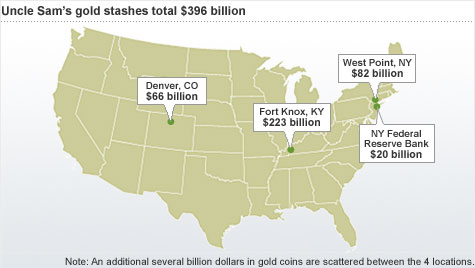Search News

NEW YORK (CNNMoney) -- This just in from the Treasury Department: The United States will not be unloading its nearly $400 billion stash of gold to delay hitting the debt ceiling.
At least not if Treasury Secretary Tim Geithner gets his way.
As the government approaches the legal borrowing limit currently set at $14.294 trillion, some have suggested the government could sell its gold reserves, as well as other assets such as mortgage-backed securities or student loan portfolio.
Reaching the debt ceiling would mean the government couldn't borrow more money, and selling assets would mean an additional revenue stream without running up any more debt.
That would buy politicians a little extra time to negotiate, chest-thump, and whatever else the debt ceiling debate will bring.
But Treasury is already warning lawmakers that holding a giant yard sale of government assets isn't a responsible move.
In a letter sent to Congress last month, Geithner said any "fire sale" of assets would be "damaging to financial markets and the economy" and would "undermine confidence in the United States."
Still, the allure is there. All that gold is just gathering dust, after all, stored in vaults in New York, Colorado and Fort Knox, Kentucky.
The Treasury Department has 261.5 million ounces of gold in its reserves, easily the biggest stockpile on earth. With gold selling at about $1,515 an ounce, that means Uncle Sam is sitting on $396 billion worth of the shiny stuff.
According to the World Gold Council, the United States holds more than twice as much gold as runner-up gold hoarder Germany.
Treasury, however, plans to keep it in the vault.
"A 'fire sale' of the nation's gold to meet payment obligations would undercut confidence in the United States both here and abroad," Mary Miller, assistant secretary of the Treasury, wrote in a blog post last week.
It would also wreak havoc on gold markets, she wrote. That assertion is echoed by Jon Nadler, senior analyst at Kitco Metals.
"Releasing even a quarter of U.S. gold reserves would do definite psychological damage to the market right away," Nadler said. "That's not a quantity that markets could handily absorb ... I don't think they'd find a buyer."
Even if the gold was successfully brought to market, the federal government's massive borrowing appetite would mean only a brief reprieve.
The United States borrows roughly $125 billion a month, a pace that would quickly erase the sale's proceeds. And when the clock expires, the debt ceiling would still have to be raised. Lawmakers would merely be kicking the can down the road.
Another wrinkle: Given the fluctuation in gold prices and other assets, a sale might be ill-timed. Take a lesson from recent British history.
When Prime Minister Gordon Brown was the nation's chief finance minister a decade ago, he decided that gold had become relatively useless to the government.
Brown sold off 400 tons, or 60% of the United Kingdom's gold, between 1999 and 2002. The problem: Gold was selling at a record low inflation-adjusted average of $275 an ounce at the time. It turned out, had he waited 10 years, the U.K. would have made five times what it hauled in from the sale. ![]()
| Latest Report | Next Update |
|---|---|
| Home prices | Aug 28 |
| Consumer confidence | Aug 28 |
| GDP | Aug 29 |
| Manufacturing (ISM) | Sept 4 |
| Jobs | Sept 7 |
| Inflation (CPI) | Sept 14 |
| Retail sales | Sept 14 |